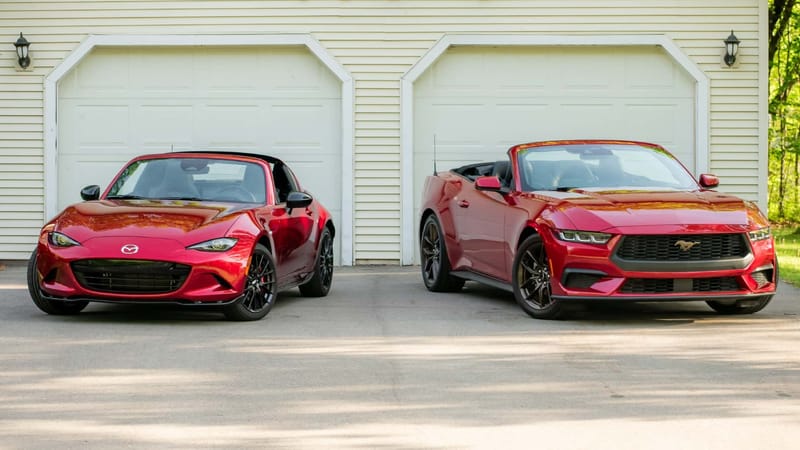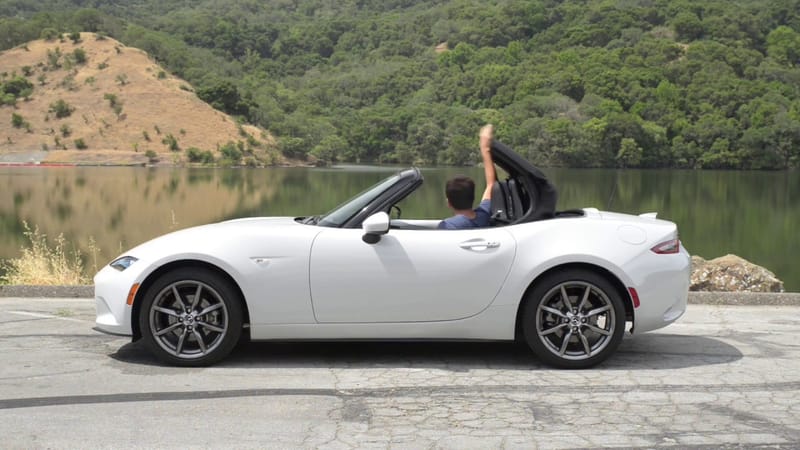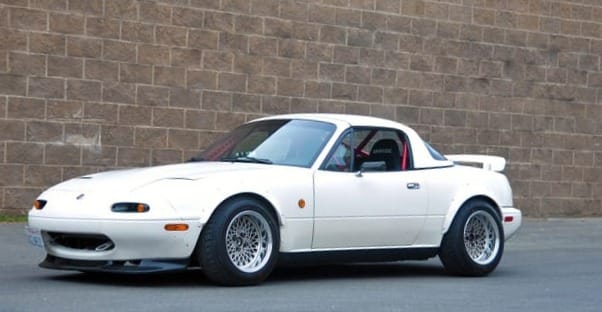Head-Turning Pop-Ups or Modern Muscle? NA vs. NC Miata
Torn between the classic NA Miata (1990–1997) with its iconic pop-ups and the modern NC Miata (2006–2015)? This guide compares styling, comfort, performance, and daily livability to help you decide. Oe of these Miatas is ready to match your driving style.

If you’re in the market for a fun and reliable two-seater convertible that can breeze through weekday traffic and still make your weekend road trips exciting, the Mazda MX-5 Miata likely has your full attention. Thanks to its lightweight roadster charm, each generation has a special flair, but many fans find themselves drawn to two standouts: the NA Miata (1990–1997), instantly recognizable for its pop-up headlights, and the NC Miata (2006–2015), a more modern spin on the same timeless formula.
Below is a closer look at both generations, comparing their styling, comfort, performance, and real-world ownership stories, all aimed at helping you decide which Miata might suit your life best.
Iconic or Contemporary?
The NA Miata carries undeniable retro appeal, highlighted by its pop-up headlights. These charming lights are a throwback to an era of quirky sports car design, one that’s almost extinct in today’s market. Beyond the headlights, the NA’s short overhangs, tight cockpit, and minimalist vibe capture the essence of vintage British roadsters, without the headache of British car reliability. Inside, the NA feels upright and spartan; storage space is minimal, and everything is built with a no-frills approach. Because these cars are now over two decades old, it’s important to watch for rust (especially around the fenders and rocker panels) and to consider whether the soft top may need replacing. Thankfully, parts are generally easy to find and relatively cheap.
On the other hand, the NC Miata has a sleeker overall profile that remains true to its roadster roots while adding a dash of modern style. A larger body doesn’t mean it’s lost its charm, just that it has a bit more presence on the road. The cockpit is notably more refined than the NA’s, boasting sturdier materials, better insulation, and improved ergonomics for everyday comfort. You’ll also find increased storage spaces (like cubbies behind the seats) and a simpler top mechanism. If equipped with the Power Retractable Hardtop (PRHT), the NC feels almost like a coupe when the top is up, lending extra peace of mind in poor weather or questionable parking situations.
Performance & Handling on the Road
The NA Miata initially came with a 1.6L inline-4 that made around 116 horsepower, later upgraded to a 1.8L at roughly 128 horsepower. While those numbers might not seem huge, it weighs in at about 2,200 lbs, making it quick on twisty roads and still decent around town. However, the shorter gearing can put you at higher RPMs on the highway, near 4,000 rpm at typical freeway speeds, leading to a somewhat noisy cruise.
In contrast, the NC Miata’s 2.0L inline-4 delivers around 167 horsepower (US spec), which translates to stronger acceleration and noticeably improved torque. Paired with a stiffer chassis, the NC corners flatter and stays composed during spirited driving. Most NCs feature a 6-speed manual that reduces revs on the highway, offering a more relaxed drive. Steering in both generations is hydraulic-assisted (a plus if you dislike today’s trend of electric power steering), but the NC’s steering tends to be heavier and more precise. Meanwhile, the NA’s charm lies in its rawer feedback, some early models even lacked power steering entirely, which boosts steering feel but makes parking a workout.

Ride quality differs slightly as well. The NA can feel taut and raw, bordering on harsh on longer commutes if you’re used to a cushier car. The NC, however, comes softer from the factory than many enthusiasts expect. A modest suspension upgrade can easily tune it to your liking. Even without modifications, the NC’s stock setup is comfortable enough for daily driving.
Daily Driving Practicality
If you’re leaning toward the NA, make sure you appreciate the classic roadster vibe because you’ll get road noise and a simpler cabin. Many people drive NAs daily, but an older car often needs extra upkeep, things like radiator hoses, suspension bushings, and belts can become priorities as the car ages. Rust is also a critical concern; it’s the main deal-breaker for many potential NA buyers.
For those who want a Miata that feels more at home on a daily commute or a road trip, the NC might be the better fit. It’s generally quieter, the engine spins at lower RPMs on the highway, and the interior has more creature comforts like better seats and easier-to-reach storage cubbies. The PRHT version, if you choose it, gives coupe-like security in unpleasant weather or if you can’t always park in a garage. Meanwhile, both generations are known for legendary reliability as long as they’re well-maintained, but the NC’s newer build might mean fewer age-related surprises.
Enthusiast Community & Mod Potential
When it comes to modifications, the NA arguably leads the pack. Because it’s been around the longest, the aftermarket is massive, you can find turbo kits, coilovers, engine swaps, and countless cosmetic tweaks to make your NA truly your own. Many folks who love hands-on projects gravitate toward the first-gen because it’s simpler mechanically, and used parts are often cheap.
That’s not to say the NC lacks potential. The market for NC upgrades has grown considerably, with plenty of choices for suspension tweaks, forced induction (turbo or supercharger), and exhaust or intake mods for a bit more power and sound. Thanks to its more rigid chassis, the NC can handle performance upgrades with fewer extra reinforcements, which is great if you’re looking for higher horsepower in a relatively low-drama package.
Resale & Collectibility
Clean, low-mileage NA Miatas are rising in value, and unmodified examples are particularly hot among collectors. With the NA pushing 25–30 years of age, it’s entering that classic car territory where nostalgia and rarity can boost the price. Meanwhile, NC models remain more approachable for your wallet. Some special editions, like NC “Club” versions, may hold value a bit better, but overall, NC pricing still represents a significant “fun-per-dollar” bargain if you want a more modern Miata without breaking the bank.
Which Should You Buy?
Ultimately, you can’t go wrong, both versions carry Mazda’s renowned reliability and the quintessential Miata charm that has attracted enthusiasts for decades. However, here’s a quick summary if you’re still on the fence:
Buy an NA if you’re all about the pop-up headlights, love a purist roadster experience, and are okay with an older car that might need regular tinkering. The smaller dimensions, direct steering, and vintage ambiance make it a cult favorite.
Buy an NC if you want a more comfortable daily driver with better highway manners and a stiffer chassis out of the box. If storage cubbies, slightly more cabin space, and a bit more power are important to you, the NC will likely be the stronger choice, especially with the optional power retractable hardtop.
No matter which generation you pick, you’re entering a welcoming community of Miata owners who love sharing knowledge, personal projects, and road trip stories. Both the NA and NC embody the spirit of lightweight fun that the Miata name is famous for. The real question isn’t whether you’ll have a blast (you will), but which version is going to put the biggest grin on your face every time you climb in for a drive.
So put the top down, turn the key, and enjoy the pure driving pleasure that only a Miata can offer. Whatever your preference, pop-up headlights or a more modern cabin, rest assured that you’re in for countless smiles per mile.




